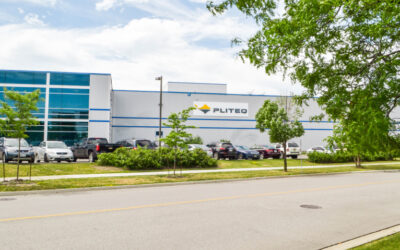As Canada continues to work toward a 2050 goal of net-zero carbon emissions, the Canada Green Building Council (CaGBC) is focused on creating a greener, more sustainable, and low-carbon building sector.
Since its formation in 2002, CaGBC has worked as a non-profit to advance green building and sustainable community development in Canada. It acts as the voice of the green building sector, supporting members who design, construct, manufacture products, finance, and operate buildings, homes, and communities across the country.
The Council introduced the globally recognized Leadership in Energy and Environmental Design (LEED) green building rating system to Canada, accelerating sustainable building practices. Today, CaGBC continues to support LEED through its certification arm, Green Business Certification Inc. Canada (GBCI Canada), and by helping shape LEED for the Canadian market with input from its steering committees and volunteer technical advisory groups.
In 2017, the Council created the Zero Carbon Building Standard to make carbon reduction the key performance metric for green buildings. As one of the largest greenhouse gas-producing sectors, the built environment offers Canada a cost-effective and proven solution to reducing carbon emissions. However, in order to make meaningful reductions, the public and private sectors will need to work together.
Research has found the building sector accounts for as much as 30 percent of Canada’s carbon emissions when construction, materials, and operations are considered, and 50 percent of emissions from cities.
“The building sector has a significant role to play, and we cannot get to our target reduction by 2030 without building new zero-carbon buildings and retrofitting existing buildings to zero carbon,” says Thomas Mueller, President and CEO of the Council.
Building on four pillars
To spur carbon reductions, the Council prioritizes four pillars or focus areas. First, having all new large construction – buildings over 20,000 square feet – built to CaGBC’s Zero Carbon Building Standard. “That creates a building stock that will emit fewer carbon emissions in the future,” says Mueller. “By growing the number of zero carbon buildings, we can increase the reduction of carbon exponentially.”
While new construction will provide substantial carbon reductions moving forward, an arguably larger and more pressing goal is the retrofit of existing buildings, the Council’s second pillar. To meet carbon targets, the Council estimates that between 50,000 and 60,000 large buildings must be retrofitted to reduce carbon and energy use over the next ten years.
While these numbers are staggering, Mueller points out that green building offers cost-saving benefits over time through reduced heating, cooling, and energy costs. Further, as the cost of carbon increases, the business case for zero-carbon buildings – new and existing – becomes even more compelling.
To help accelerate retrofits, CaGBC and GBCI Canada brought the Investor Confidence Project, or ICP, to the Canadian market. The ICP is a global underwriting framework for developing and evaluating energy efficiency retrofit projects and includes the Investor Ready Energy Efficiency (IREE) certification.
By outlining requirements for energy efficiency retrofits with transparent industry standard protocols, the ICP helps reduce development transaction costs, streamline project assessment, and increase investor confidence in energy efficiency outcomes.
The retrofit landscape is expected to heat up with the Canada Infrastructure Bank’s Building Retrofits Initiative, which has earmarked $2 billion to finance public and commercial retrofits. The Initiative will use the ICP’s IREE certification to qualify all its commercial projects for financing.
“Billions of dollars need to be unlocked and allocated to retrofit large buildings now,” says Akua Schatz, CaGBC’s Vice President of Market Engagement and Advocacy. “The ICP protocols and IREE certification can help by assuring investors that planned retrofits will deliver on the anticipated energy and operational savings. The confidence an IREE certification provides will help make investments in retrofits that much more attractive.”
Going private
Indeed, while government investment is on the rise as part of the post-pandemic recovery spending, the goal was to see a strong commitment from private sector investment as well. Over the past few years, private investment has risen along with confidence in the technical and financial viability of deep energy efficiency retrofits to deliver meaningful energy and carbon cost savings.
Indeed, five of Canada’s top banks, among other lenders, see green retrofits as a low-risk investment opportunity. For example, Vancouver City Savings Credit Union, or Vancity, is a leading investor in retrofit projects, including a recent IREE-certified condominium project in Toronto, Ontario.
Another way to increase private investment and make retrofits more attractive to investors is by aggregating projects – something made easier when you have a common set of goals and standard asset classes defined.
“Right now, retrofits are done on a ‘one by one by one’ basis, meaning every one of those projects is a unique snowflake,” Schatz says. “Standardizations like the ICP Protocols and IREE certification are a critical underpinning for success and a mark of a mature market because now you can aggregate projects and deliver increased carbon reductions.”
Better places to live, work and play
A third pillar for CaGBC is the co-benefits of green building. Advances in ventilation, heating, and cooling not only provide carbon reduction and energy savings but also improve the quality of life for occupants.
CaGBC’s Vice President of Green Building Programs Mark Hutchinson explains that the Council constantly re-examines what environmentally friendly construction means and helps to shape approaches to create better, healthier buildings and communities. “Our green building efforts not only include external environmental impacts but impacts to human health and well-being as well.”
With their focus on air quality, natural light, better acoustics, and safer materials, green buildings are healthier for the people in them. The benefits of green building are well-known, including increases in cognitive scores and learning outcomes, better sleep, and improved health metrics.
Over the last year, health and safety were especially top of mind. Building owners and operators were focused on necessary precautions in the face of the global pandemic. “What we’ve heard from the market is that buildings that have pursued third-party performance certifications such as LEED and have used tools such as ARC are better positioned to comply with re-entry requirements,” Hutchinson says. “Because LEED requires building managers to track so many measurements of building health and occupant experience, these buildings have already internalized the practices that may be required for safe re-entry.”
A future workforce
The Council’s fourth pillar is stimulating interest in the construction sector. The Council is taking an active role in developing a future workforce skilled in green building, an often-overlooked gap when it comes to implementation readiness.
As demand for zero carbon buildings grows, Canada’s building sector must possess low-carbon skills and knowledge. CaGBC has published three reports looking at the low-carbon skills gaps facing construction trades, as well as engineers, architects, and renewable energy specialists. Now, the Council is helping mobilize the entire sector to grow and train its workforce.
One way CaGBC is advancing this goal is through Workforce 2030. This Ontario-focused coalition brings together over 50 organizations including developers, labour unions, tradespeople, architects, manufacturers, and more.
The coalition is working to overcome impediments to low-carbon upskilling and growing the green building sector’s workforce. By working together, Workforce 2030 participants aim to address projected construction workforce shortages and also transition COVID-impacted workers into green building jobs.
The potential for significant job growth is there. CaGBC research estimates that by 2030, with sufficient government action and proactive policies, over 600,000 green building jobs could be created in Ontario alone, and 1.5 million across Canada.
Schatz says that, at the time of this writing, the coalition is launching a two-year initiative to train new workers in green building skills. “We are connecting marginalized workers and those impacted by COVID with training opportunities through four different programs,” she says. “And further down the line, this work will also help connect those individuals with green building jobs.”
The coalition is also using its influence to diversify construction, which has historically been male-dominated.
“There’s a great opportunity for the building sector to grow, not just from a gender diversity perspective, but through an overall diversity lens,” Schatz remarks. “I think there’s a lot of untapped potential here.”
With success in Ontario, Schatz and her colleagues hope Workforce 2030 can be a pilot program for other provinces to follow. “That’s definitely something that we are exploring right now,” she confirms.
With growing national support and a clear mandate, the CaGBC is working tirelessly to transition the building sector toward a low-carbon future. And thanks to new workforce development efforts like Workforce 2030, Canada’s building sector will acquire the skills and personnel needed to make a meaningful contribution to Canada’s carbon reduction efforts.













